Posts Tagged ‘cyanotype’
HILL END ANALOGUE: Our Cyanotype Works
We are excited to announce that a selection of our Cyaanotype artists books was presented at the Hill End Analogue event.
.
HERE’S THE BACK STORY
Hill End Analogue ( HEA ) is an analogue photographic arts festival presented by Hill End Arts Council Inc. ( HEAC ) in the Central West township of Hill End, N.S.W. HEA
showcased and connected contemporary analogue photographic artists world-wide. The event comprised exhibitions and workshops, the festival engaged with the general community, while promoting contemporary analogue arts and technology.
Hill End is an historic site, managed by N.S.W. National Parks Wildlife Service, and is significant in the history of Australian Photography. The documentation of Hill End and surrounds during the gold boom of the 1870’s by Beaufoy Merlin and Charles Bayliss, forms a large part of the Holtermann Collection in the N.S.W. State Library. Hill End has a thriving arts community, supported by the Bathurst Regional Art Gallery and is closely associated with the National Art School.
(Text modified from the HEA website)
.
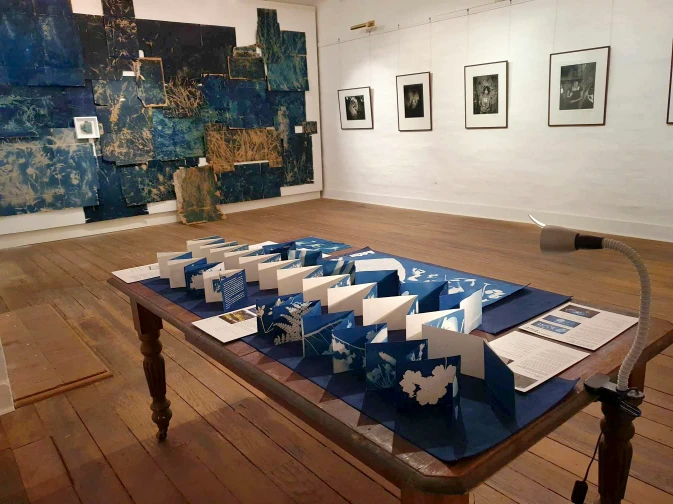
Hill End Analogue Installation PHOTO: Courtesy of Lisa Sharkey
.
OUR CYANOTYPES
.
MORE INFORMATION ON THESE CYANOTYPE WORKS
.
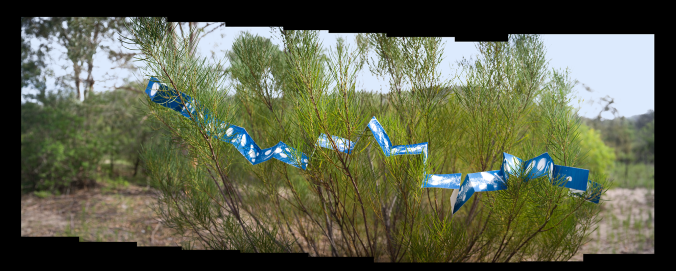
Victoria Cooper’s “Flood” in situ on the island Bundanon
.
FLOOD An artists book by Victoria Cooper
MEDIA: Concertina format with 26 pages, cyanotype on Arches watercolour paper with hand-set type in black ink
Binding by Doug Spowart
SIZE: 10 x 15 x 3cm cm
EDITION: Two unique states
Download a didactic about this book: COOPER – Flood installation at Bundanon
.
.
.
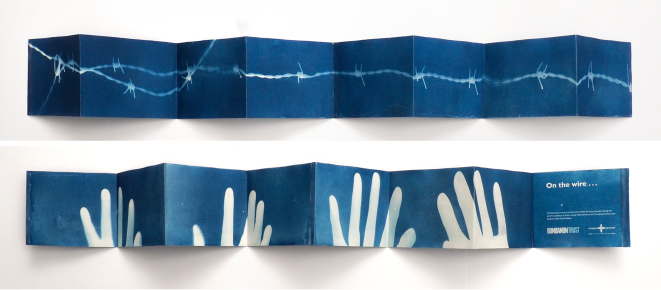
On the wire … A book by Doug Spowart
.
ON THE WIRE … A book by Doug Spowart
A performance based on open-air cyanotype bookmaking directly off subjects in the field.
CREATED: 2007 at Bundanon during an artist in residence
MEDIA: 16 sided concertina format book of double-sided cyanotype images on Arche Aquarelle watercolour paper
SIZE: 11 x 14 x .4 cm – extends to 116 cm
EDITION: Unique state 2 variants
Download a didactic about this book: SPOWART – On the wire – extended recto+verso
.
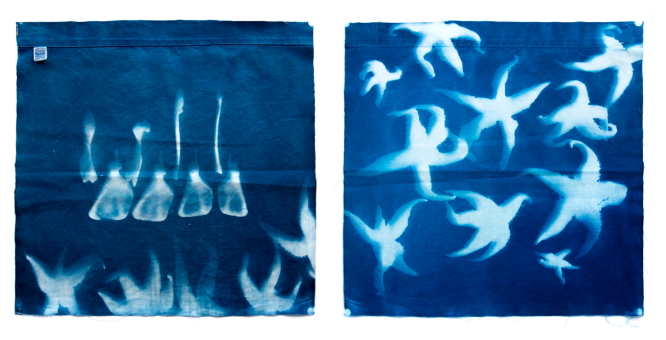
Starfish swarm with wallaby bones by Victoria Cooper
.
STARFISH SWARM WITH WALLABY BONES An artists book by Victoria Cooper
A double-sided cyanotype made from objects gathered in Tasmania. The work was made to celebrate the 2019 World Cyanotype Day.
CREATED: 2019 in Cygnet, Tasmania
MEDIA: Cyanotype on recycled linen pillowcase
SIZE: 30 x 30 cm
EDITION: Unique state
Download a didactic about this book: COOPER-Starfish swarm an wallaby bones
.
.

Roland Barthes an artists book by Doug Spowart
.
ROLAND BARTHES An artists book by Doug Spowart
Roland Barthes the French writer and theorist, has contributed significantly to the discourse and critique of photography. This book is a visual comment on two of his texts.
CREATED: 2017 at Bundanon during an artist in residence
MEDIA: Concertina format with 16 pages, cyanotype on Arches watercolour paper
Binding by Doug Spowart
SIZE: 11 x 14 x .4 cm
EDITION: Two unique states
Download a didactic about this book: Doug SPOWART -Barthes
.
.
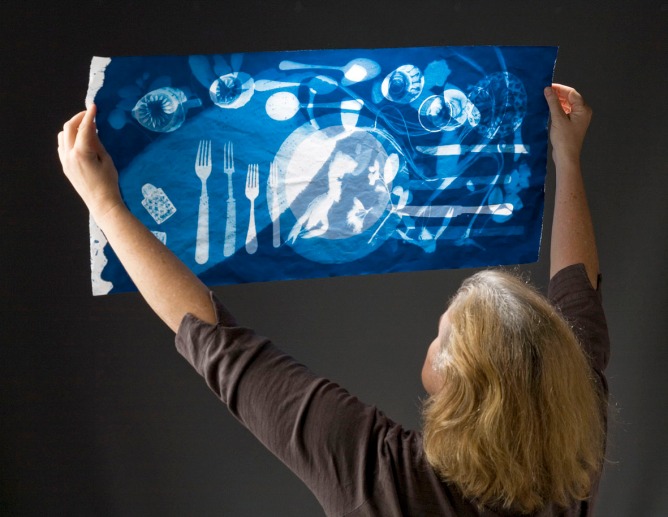
AUSTRALIAN BANQUET: January 26 / 26, 1788 by Cooper+Spowart
.
AUSTRALIAN BANQUET: January 26 / 26, 1788 by Cooper+Spowart
This work reflects on the ‘turning of the page’ in history that Australia Day represents.
CREATED: 2010 on Australia Day in Toowoomba
MEDIA: A unique state double-sided cyanotype on rice paper broadsheet of 7 variants.
SIZE: 37.6 x 77cm
Download a didactic about this book: COOPER+SPOWART – Australian banquet
.
.

PHOTOGRAPHS OF ARTHUR’S GARDEN A book by Doug Spowart
.
PHOTOGRAPHS OF ARTHUR’S GARDEN A book by Doug Spowart
A cyanotype concertina book made on the veranda of Arthur Boyd’s studio during an artist in residence
CREATED: 2007 at Bundanon
MEDIA: 24-sided concertina book. Cyanotype on Arche watercolour paper
SIZE: 11 x 14 x .4 cm – extends to 168 cm
EDITION: Unique state
Download a didactic about this book: SPOWART – Photographs of Arthur’s Garden – extended
..
.
.
.
.
THANKS TO: Lisa Sharkey and the Team for the opportunity to present these works at Hill End Analogue.
The photograph of the HEA installation courtesy of Lisa Sharkey
Text and cyanotype works and photographs © Doug Spowart+Victoria Cooper
.
.
.
.
HOME: Our exhibition at GALLERY ON OVENS

.
WE NOW LIVE IN BENALLA in north-eastern Victoria, and to celebrate we held an exhibition at GALLERY on OVENS in May 2022.
.
A STATEMENT ABOUT THE EXHIBITION
Great writers, artists and philosophers have considered the physical, psychological, emotional and political place we call HOME. We reflect and are inspired by their work as we consider our personal perceptions of home personal within the broader human condition.
We have been artists and collaborators for over three decades. Our HOME has been: a house in a suburb or town, our car, a friends place, an artists in residence, a studio, a library, a campsite, a motel room. Whether stable or temporary the places we have inhabited – their architecture, history, social condition or collected objects have evoked our creative and questioning thoughts about perceptions of existence.
For us all these places we call HOME are spaces where we can contemplate, re-invent, conceive, originate, initiate new ideas for the future. We use the broad palette of our arts practice including – Camera obscuras, Cyanotype printing, Pinhole photography, Projections, Light painting and Nocturne light and the resolved artworks are presented as wall-images, artists books and photobooks.
.

COOPER+SPOWART – Home exhibition montage
.
.
In this post we report on the exhibition and the works it contained relating to the concept of HOME …
.
PREPARATION

Gallery on Ovens installation planning
.

Selecting work and preparing work
.
THE INSTALL
.
THE EXHIBITION

Table view of artists’ books

Gallery on Ovens window

Exhibition duo

Cyanotype wall

Looking at books with Maggie
.
THE DE MOUNT

The de Install
.
DOWNLOAD A “HOME” CATALOGUE – “CLICK” HERE

Catalogue Book Cover
.
.
.
.
Images and texts ©Cooper+Spowart 2022
.
.
.
A TASMANIAN CYANOTYPE: Untitled Found Objects by Victoria Cooper
 Untitled found objects a cyanotype by Victoria Cooper
Untitled found objects a cyanotype by Victoria Cooper
Untitled Found Objects is created from a collection made of invasive starfish species colonising parts of Tasmanian waters and a map-shaped beer coaster found discarded in the streets of Hobart. In this work I play with these found objects and speculate on their relationship with Place.
.
 Found objects: Starfish and Tasmanian coaster map
Found objects: Starfish and Tasmanian coaster map.
When I take the time to study a place through photography and Material Thinking* history is unearthed, reconsidered and reordered. As I walk in each place, I identify and collect objects for further study. Some objects are commonplace or endemic while others may be discarded or dislocated dissonant interventions. I then utilise the cyanotype process as a site-specific medium to record these collections using sunlight and other environmental conditions as experienced in-situ. In this work the cyanotype forms a blue matrix in which these objects are imaged as their shadows. The shadowy imprints inhabit the blue as white ghostly forms referential of their solid origins.
The final work of blue and white is a paradox between its fiction and truth, the featureless blueness only revealing form by its absence. To think about the cyanotype in this way ushers in many questions: Is the cyanotype blue a political or aesthetic statement? Do the white shadows speak of absence or are they the essence of a presence? Does the reader need an exegesis to understand a poem?i
Victoria Cooper
.
 Untitled found objects exposing the cyanotype
Untitled found objects exposing the cyanotype
*The concept of an aesthetic methodology proposed by Paul Carter in his book, Material Thinking, defines my art, and underpins the making of my work. Through a psychological dialogue with materials, subjects and objects, my work evolves reflexively and in concert with the response to physical experience of time and place. In this process I am taken in new directions and presented with unexpected outcomes for the work.
Just as human collaborators needed to suspend an irritable desire for control of the project, substituting instead a lover’s readiness to be plastically moulded by the other’s (intellectual) desire, so with materials: they self selected, those of especial value to enquiry displaying gifts of amalgamation and self transformation analogous to the emotional environment characteristic of the human exchange. (Carter 2004:xiii)
Paul Carter, 2004, Material Thinking, Melbourne University Publishing Ltd, Melbourne.
.
.
.
.
.
.
©2019 Victoria Cooper
1788–January 25th, the next day, and now
In 2010 we wanted to make an artwork to comment and reflect on Australia Day and some of our feelings about the origins of the date – the implications of that event and the repercussions that we live with and navigate today. Through a scorchingly hot day in Toowoomba we worked with cyanotype solutions and selected objects – some from our home and others sourced from the food scraps from a local seafood smorgasbord restaurant on the day.
The work that we did that day emerged as the collaborative artists’ book, a broadsheet we titled, Australian Banquet, January 25/ 26, 1788.
A statement about the artwork
Across Australia over the January 26th long weekend, people prepare, cook and consume food to mark this day in history.
For us, this work is our response to, and in recognition of, the ‘turning of the page’ in Australian history that this date represents. One day, January 25th 1788, Aboriginal people feasted on a diverse banquet of bush tucker as they had for thousands of years. The next day, the country was transformed by a new paradigm represented in this work by the table setting of the First Fleet.
Australia Day, for us, is an important time to acknowledge the First Peoples’ perspective and their knowing of land, culture and history and how it should be recognised as underpinning the diversity and identity of contemporary Australia. We, as descendants of European people, are seeking to understand and know more about our place within the longer history of this land.
.
The 25th of January side of the broadsheet is viewed and contemplated.
.
The broadsheet is then turned over to view the 26th of January side.
.
Finally the broadsheet is held up to the light – the complex interrelationship between the two visual references to be seen and considered.
BOOK DESCRIPTION: A unique state artists’ book broadsheet
TITLE: Australian Banquet January 25/26, 1788
MEDIA: Double-sided cyanotype image in rice paper
DIMENSIONS: 37.6 x 77cm
PLACE & DATE MADE: Toowoomba, Queensland, Australia, 2010
EDITION: 7 variations
EXHIBITIONS & AWARDS:
2015 EXHIBITED: Books by Artists, The Webb Gallery as part of the Artists Book Brisbane Event, Conference at the Queensland College of Art, Brisbane
2014 EXHIBITED: Alternative Imaging – Curated by Dawne Fahey at Two Doors Gallery, The Rocks, Sydney
2011 SHORTLISTED: Southern Cross University Artists’ Book Award, Lismore. Judge: Ross Woodrow
2011 EXHIBITED: BLUE – Arts Council Toowoomba members exhibition, Toowoomba Regional Art Gallery
2010 FINALIST: Josephine Ulrick & Win Schubert Photography Award,
………………………Gold Coast City Gallery. Judge: Judy Annear
COLLECTIONS: Australian Library of Art, State Library of Queensland
.
.
.
.
.
.
.
..
.
.
.
.
.

.
.
.
.
CYANOTYPE IN AUSTRALIA @ MGA – An exhibition & Workshop
We are excited to announce an exhibition of the work of Australian cyanotype practitioners for World Cyanotype Day 2018 has now opened.
Over the last month we’ve been working with Stephanie Richter and Gillian Jones of Monash Gallery of Art in Melbourne to bring together the cyanotype works by artists from north Queensland to Tasmania to exhibit in the MGA’s ATRIUM GALLERY.
We also presented a one day masterclass on the cyanotype and the book.
The exhibitors are:
Adele Outteridge, Ann Vardanega, Chris Byrnes, Christina Harding, Danielle Minette, David Symons, Dawne Fahey, Deanna Hitti, Felicity Rea, Gael E Phillips, Gail Neumann, Jan Ramsay, Janis House, Kate Golding, LeAnne Vincent, Linsey Walker, Lloyd Godman, Lynette Zeeng, Mark Lourensz, Mel Brackstone, Mollie Bosworth, Raimond De Weerdt, Renata Buziak, Robyn Campbell, Shane Booth, Silvi Glattauer, Sue Clisby, Thomas Oliver, Trevor Foon, Stephanie Richter, Victoria Cooper and Doug Spowart.
A copy of the exhibition catalogue can be dowloaded ‘In Anna’s Garden’ CATALOGUE
A video of the gallery installation can be seen here…
.
THE STORY OF THE EXHIBITION from Victoria Cooper + Doug Spowart
For around 2 years we have been members of the World Cyanotype Day Facebook page and have followed the work and comments made by cyanotypists from all over the world. When the call went out about the 2018 World Cyanotype Day (WCD) we shared the post on our Facebook page with the message, ‘wouldn’t it be fantastic if we could have an exhibition of practitioners from Australia to celebrate WCD’. Within minutes our Facebook Friends started responding with supporting comments like, ‘WOW, I’d like to be a part of that!’ Within 24 hours about 20 ‘Likes’ and comments appeared – we then thought about how we could make it possible.
In September we were scheduled to be in Melbourne so we made some enquiries with a few contacts about the possibility of an exhibition space that we could consider for the project. Things went quiet for a while and we sent out a few follow up messages. Then came a response from Stephanie Richter, the Monash Gallery of Art’s Education & Public Programs Coordinator, that the Community Access space at MGA could be available. After consultation with the Director Anouska Phizacklea and the MGA team the go ahead was granted to mount the exhibition and present a masterclass in the process. An event team was formed consisting of Stephanie, Gillian Jones – a recent Master of Arts and Cultural Management student from Melbourne University with Vicky and myself.
A Facebook Group was established and people who we knew were practising cyanotypists were invited to join. Through our contacts in alternative and traditional photography we enquired about other cyanotype workers that we should be aware of to extend to them an invitation to contribute to the show.
In time documents outlining the project, conditions of submission and important aspects of the venue and the audience were generated and made available online. Some invitees were contacted via email, as they were not Facebook users.
The closing dates for submissions, delivery to the gallery and installation all had tight deadlines. The FB group was able to provide a rapid distribution of information, an ability to respond to questions and circulate the answers back to the group. Behind the scenes the event team connected via Facebook Messenger to plan, resolve and prepare the way for the exhibition. Early in September the works were received at the gallery and a 3-day installation took place by the event team supported by artist Deanna Hitti. The exhibition was opened on the 15th of September and will remain on show until the 21st of October.
In Anna’s Garden presents a diverse and vibrant community of cyanotype artists and photographers working in Australia. Although the exhibition is not a complete survey, it does represent a beginning in recognizing the practice of this process in Australia. Also planned is the continuation of an openly accessible ‘The Cyanotype in Australia’ Facebook page to provide a place for networking and the sharing of concepts, techniques and images with the local, national and international communities.
The growing popularity of this early photographic process could seem strange at a time when instant perfection is so easily achieved through digital technologies. Perhaps the allure for the cyanotype lies in its hand-made working methods and technologies along with the potential for capricious results that inevitably lead to an excitement in the discovery new ways of seeing. For many the emotional power of the cyanotype’s blue image continues to create new perceptions through visual expression and storytelling 176 years beyond its first discovery.
.
SOME IMAGES FROM THE EXHIBITION
.
.
.
.
.
National Works on Paper submission – not shortlisted
.
As an artist there is a need for affirmation and justification for one’s life in the activity and practice of artmaking. Artists prepare and curate their work in gallery exhibitions to present work – and then there are awards and competitions. Each year, as the call for entries comes around, we like many artists around the country, look at recent work and consider its appropriateness for specific awards.
There are of course thoughts of winning an award but perhaps more importantly is the opportunity to be shortlisted for exhibition and considered for purchase or collection. Equally important for us is the opportunity to connect with fellow artists in the curated exhibition that represent the judge’s opinion of what constitutes the most relevant works based on the competition’s criteria.
This year I submitted to the National Works on Paper Award an artists’ book that I had made during our Skopelos Works on Paper workshop in Greece last year. The book is an exploration of the idea of a montage of light capturing the performance of reading a book. Simultaneously the reader, the location where the reading took place and the page-turning action of reading is imaged in light sensitive cyanotype on the watercolour pages of the book.
.
Here’s an image of the book:
.
Other images of SKOP PHOTO folder, cover and details
ARTIST’S STATEMENT: SKOP PHOTO an artists’ book by Doug Spowart
This book is created using the cyanotype (sun print) process as part of the author’s ongoing investigation on the ontology of reading.
The book was folded into a concertina form to eventually allow for a variety of potential readings; either extended or page after page. The author then coated the light sensitive cyanotype emulsion onto the pages of the book.
The pages were slowly turned and extended over several minutes allowing the sunlight of the Greek island of Skopelos to strike the emulsion as author performed reading.
After washing in a bath of water, an image of the Aegean light was formed in Prussian blue on the pages of the book. Alternatively, where the light had not fallen on the page – there seemed to be no image formed. But this apparent absence was a “shadow” – a kind portrait of the artist reading the book in its moment of creation.
Today I received an email advising that my submission was not shortlisted..
.
Not a big problem for me as only 1 in 16 artworks were accepted for the 2018 awards and those names on the list are a fine group of artists.
.
If you are interested the 2018 National Works on Paper finalists were:
Raymond Arnold, Peter Atkins, Alec Baker, Martin Bell, Ray Besserdin, Solomon Booth, David Bosun, Godwin Bradbeer, Kate Briscoe, Jane Brown, Jon Campbell, Susanna Castleden, Danica Chappell, Hua Cun Chen, Sam Cranstoun, Lesley Duxbury, Robert Fielding, David Frazer, Ian Friend, Dana Harris, Katherine Hattam, Pei Pei He, Kendal Heyes, Mark Hislop, Deanna Hitti, Anna Hoyle, Natalya Hughes, Alana Hunt, Locust Jones, Jennifer Joseph, Noŋgirrŋa Marawili, Brian Martin, Georgie Mattingley, Mish Meijers, Viv Miller, Helen Mueller, John Nixon, Open Spatial Workshop, Elena Papanikolakis, Louise Paramor, Hubert Pareroultja, Jemima Parker, Riley Payne, Dan Price, Lisa Reid, Louise Rippert, Cameron Robbins, Brian Robinson, Elissa Sampson, Emily Sandrussi, Geoff Sargeant, Jo Scicluna, Liz Shreeve, William Smeets, Kylie Stillman, TextaQueen, James Tylor and Laura Wills, Trent Walter, Rosie Weiss, Mumu Mike Williams, Puna Yanima, Yvonne Zago, Tianli Zu.
Exhibition details at the Mornington Peninsula Regional Art Gallery:
The opening event and award presentations will take place on Saturday 21 July from 4-6pm. An electronic invitation will be sent to you closer to the date.
Now I’m looking forward to 2020
In the meantime I’ll be pursuing some more cyanotype documentations of the act of reading – maybe during our upcoming Bundanon Artists Residency in June…
.
.
,
CYANOTYPE: Working the ‘blues’ in Greece
.
The azure blue of the Aegean Sea perfectly matches the prussian blue of the historic process cyanotype. The ancient stories of Ulysses and Jason’s Argonauts lend themselves to the contemporary narratives that can be made through photography and the photobook. In May we sought to explore these creative possibilities through a collaborative workshop coordinated by artist Steph Bolt and Skopelos Works on Paper on the island of Skopelos located in the Sporades north-east of Athens.
Six participants worked with us over a two-week program of structured lectures, practical sessions and photo forays to explore the possibilities for image taking and art making on the island. Staying in the main town on the island we worked out of the purpose-built printmaking studio with a view out over rocky headlands, distant islands, blue waters and skies. The studio sits atop of the town next to the remains of a castle with steps and paved pathways leading to the harbour and the Paralia. Tourism is a significant industry for the island however its impact does not destroy a feeling of being within an authentic experience of Greece.
The workshops started with breakfast daily at 8.30am with a studio start at 9.00am. By 2.30pm the formal program finished enabling personal exploration of the diverse subject matter available. Everyday participant’s day concluded in the restaurants of the Paralia partaking in the culinary delights of rustic Greek food supported by ouzo, retsina and aspro krasi (white wine). We ate fantastic squid, octopus, anchovies, little fishes, rabbit, goat, traditional foraged foods like the succulent kritima, local cheeses, Skopelos pies and gyros. Some members of the group formed relationships with the restaurateurs and towards the end of each meal extra wine and special desserts were presented as gifts by the host.
At regular intervals in the program Steph and her husband Robin took us on photo adventures: to the ancient graves at Sendoukia for sunrise, the Roman bathhouse ruins of Loutraki, the hillside town of Glossa and the classic white rocky cliffs and beaches of the island. The island is also famous for providing the setting for the Bronson and Streep film, Mama Mia so we visited the famous church on the rock Agios Ioannis. As part of most of these forays we had more opportunities to dine in tavernas, coffee shops and seaside restaurants.
Key to the program was the concept of ‘place-making’, that is making photographs and forming them into themes and photo-essays that told of the personal experience of place by the photographer. The process of the cyanotype was explored employing traditional ‘shadow’ imprint of objects collected from the island to some very experimental work with multiple materials and exposures and double-sided printing. We worked not only with art papers but also with rice paper, various cloth materials event kitchen paper towelling. We had also gathered some special objects like a range Greek laces and linens, local rocks and a diverse range of plant material. Connecting direct photography with the cyanotype process was achieved on-site by the making of enlarged inkjet negatives.
Photobooks were developed at first as mini-book projects that could lead to online projects with MomentoPro software. MomentoPro supported the project by accrediting our program as part of the ‘Club’ services giving the participants 40% discount on their first book and 10% on each of their future books.
The participants were accommodated near the studio at the top of the town – one group had extensive views of the Aegean Sea sunrise with the other group overlooking the town. As mentioned earlier the distance to the shops and restaurants in the harbour required the negotiation of several hundred bespoke steps of local stone and concrete all with their leading edge painted white. The steps meandered past mainly two storied whitewashed houses with ornate doors and grilles. Ancient churches some built with reclaimed stones from other building provided an experience of place that was quite memorable. Coming home from shopping or dinner meant a steep climb up through the paths, sometime dodging motorcycles although many steps are so narrow that even they are footpaths alone. On one early evening return we encountered a church group with candles being led in a song procession with a Greek Orthodox priest leading the way – a memorable moment indeed.
The weather was very changeable requiring some program shuffles, as cyanotypes are direct sun exposures for many minutes. Ah! Today is sunny – we’ll make cyanotypes then… Once participants grasped the technique each took the process in their own directions. Many sophisticated books were made based on other workshop classes in book binding and finishing. Some went BIG making full sheet (55x76cm) cyanotypes.
At the beginning of each workday a review of the previous activities was undertaken. The specific needs of each participant could be covered and ideas shared.
On the final day each photographer presented their best work – what an amazing body of work that represented – although within hours each had said their goodbyes and had caught ferries off the island and were flying homeward. We were all jealous of Steph and Robin who have a house in the town and stay there for about half the year. Their knowledge of the island and networking with island people was invaluable for the success of the workshop. Works were shared and a folio set of eight small books were made in multiple so everyone ended up with a memento from each of other individual experiences …
All of us were touched by something special on the island – our photographs and books act as evidence of experience but also a touchstone to relive and share those experiences…
Here are some photos of the final presentations…
Copyright in the text and all photographs are the copyright of Doug Spowart+Victoria Cooper unless otherwise indicated. The copyright of the artworks is held by the artists.
.
FIELD STUDIES INTERNATIONAL 2016: Our contribution
We have been busy the last few days completing our contribution to the 2016 Field Study International report project. Led by David Dellafiora in Geelong the Field Study project is now in it’s 22nd year. Field Study Report contributions are called emanations and can include all kinds of things including: ‘documentations of performances, actions and exhibitions, tracts, rants, instructions, manifestoes, reflections and experiments.’ They are a mashup of Fluxus, DaDa, Surrealist inspired, zine-ish paste-up, rubber stamps, torn up letter ransom notes and concrete poetry. The Field Study Report becomes a snapshot of artistic, social and/or political commentary at the time of its publication.
Our submission for 2016 is a commentary on our present nomadic lifestyle. Since moving from Toowoomba 2½ years ago we have been house-sitting, doing artists in residence projects, staying with friends and renting – we have lived in approximately 15 places.
For our submission we made a diptych of original cyanotype images recently while staying on the beach at Wooli. One print represents a starry night above a line of houses. The other print is a selection of of different keys –referencing all the houses we have stayed in. The two cyanotype prints were copied, scaled and arranged on the one sheet with the captions: ‘Keys to the homes where we have lived …’ and, ‘A Field Study Emanation for 2016 by Victoria Cooper + Doug Spowart’.
Each A5 print is numbered and signed and the edition is 100. Each contributor gets a copy of the assembled works and some copies are sold to support the project and the group that helps make it happen.
Submissions for 2016 are now closed however, get ready for 2017. For more information about Field Study and other projects see: https://daviddellafiora.blogspot.com.au/
About Field Study:
Field Study began in 1993 as a way of reclaiming the negative spaces between art and life. Activities stemming from Field Study are emanations and group emanations are manifestations. Field Study sees each work as a manifestation of a collective spirit. Everyone is welcome to become a member of Field Study, irrespective of their arts practice, and contribute to the Field Report. Field Study also produces the assembling publications WIPE and ReSite, and, in collaboration with Karingal, KART.
An earlier WOTWEDID Blog post has more detail… Check it out:
https://wotwedid.com/2013/01/05/field-study-international-our-contribution/
.
.
.
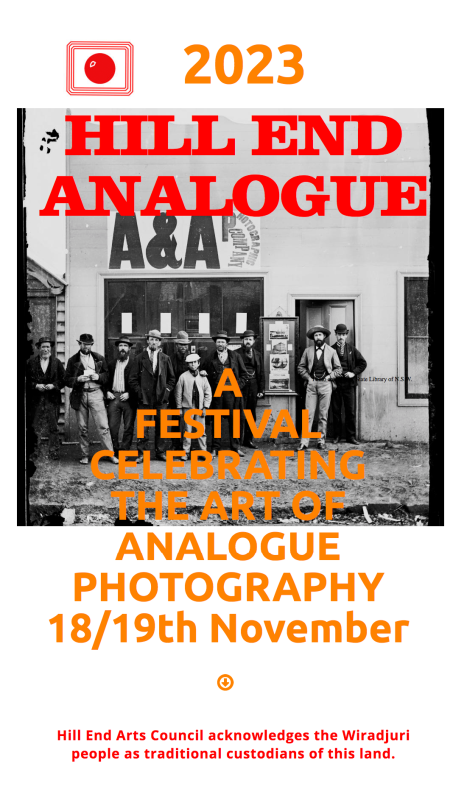






























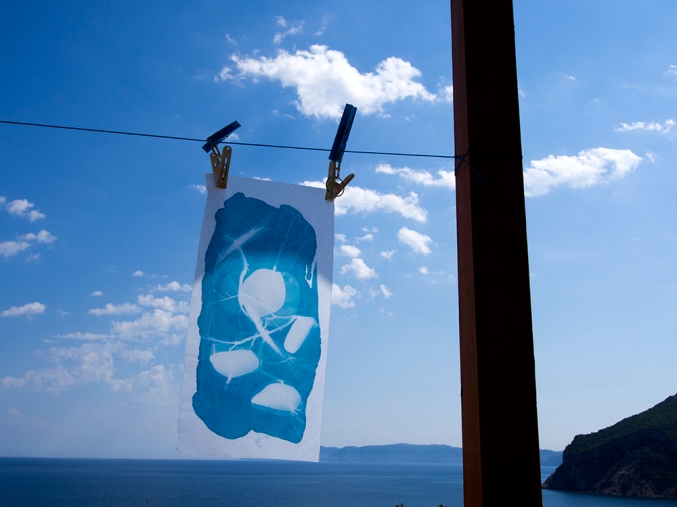






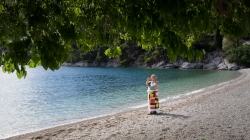





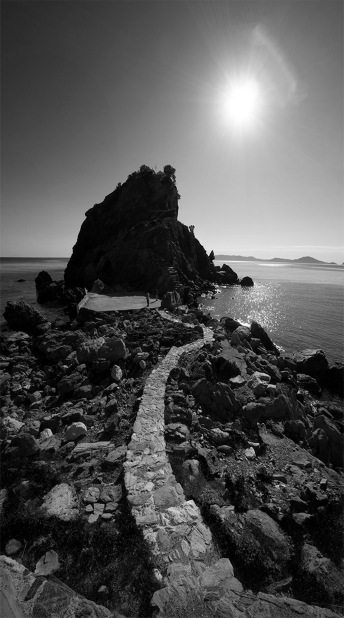








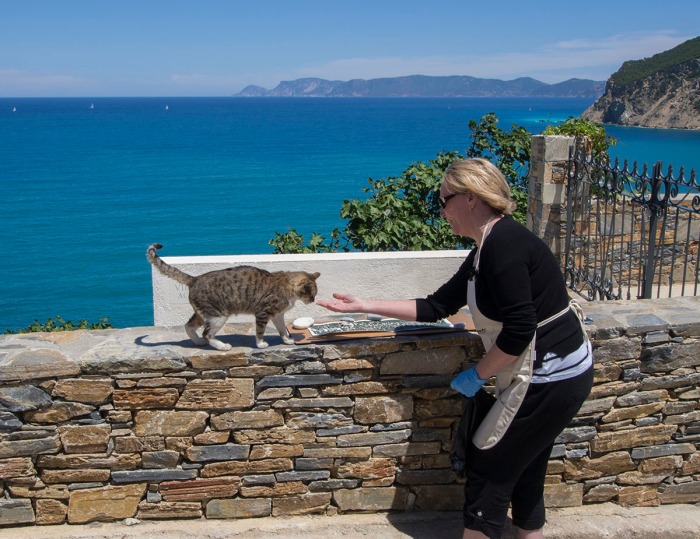







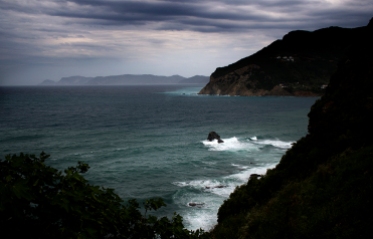

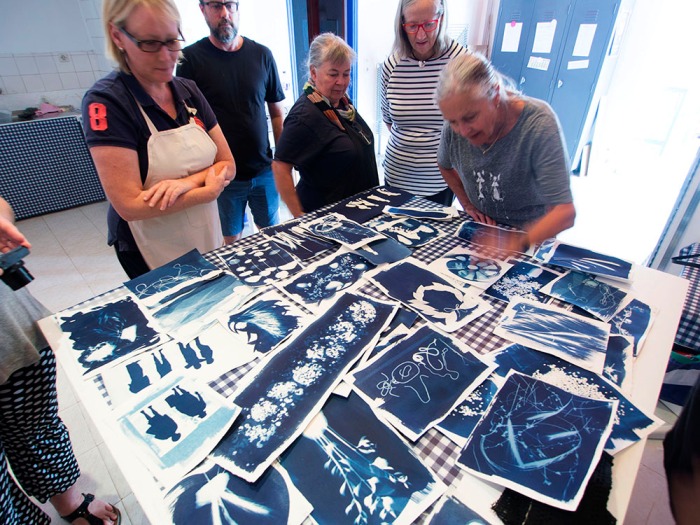














BRITISH LIBRARY Acquires our cyanotype artists’ book
with 5 comments
A statement about the artwork
Across Australia over the January 26th long weekend, people prepare, cook and consume food to mark this day in history.
For us, this work is our response to, and in recognition of, the ‘turning of the page’ in Australian history that this date represents. One day, January 25th 1788, Aboriginal people feasted on a diverse banquet of bush tucker as they had for thousands of years. The next day, the country was transformed by a new paradigm represented in this work by the table setting of the First Fleet.
Australia Day, for us, is an important time to acknowledge the First Peoples’ perspective and their knowing of land, culture and history and how it should be recognised as underpinning the diversity and identity of contemporary Australia. We, as descendants of European people, are seeking to understand and know more about our place within the longer history of this land.
.
View 1: Australian Banquet, January 25/ 26, 1788
The 25th of January side of the broadsheet is viewed and contemplated.
.
View 2: Australian Banquet, January 25/ 26, 1788
The broadsheet is then turned over to view the 26th of January side.
.
View 3: Australian Banquet, January 25/ 26, 1788
Finally the broadsheet is held up to the light – the complex interrelationship between the two visual references to be seen and considered.
BOOK DESCRIPTION: A unique state artists’ book broadsheet
TITLE: Australian Banquet January 25/26, 1788
MEDIA: Double-sided cyanotype image in rice paper
DIMENSIONS: 37.6 x 77cm
PLACE & DATE MADE: Toowoomba, Queensland, Australia, 2010
EDITION: 7 unique state variants
SOME REFLECTIONS ON THE BOOK’S HISTORY
COLLECTIONS, EXHIBITIONS & AWARDS:
2020 COLLECTION: British Library
2015 EXHIBITED: Books by Artists – The Webb Gallery as part of the Artists Book Brisbane Event, Conference at the Queensland College of Art, Brisbane
2014 EXHIBITED: Artist’s Books (reprised) [artists’ books 1978-2014] – George Paton Gallery, University of Melbourne
2014 EXHIBITED: Alternative Imaging – Curated by Dawne Fahey at Two Doors Gallery, The Rocks, Sydney
2011: COLLECTION: Australian Library of Art, State Library of Queensland
2011 SHORTLISTED: Southern Cross University Artists’ Book Award, Lismore. Judge: Ross Woodrow
2011 EXHIBITED: BLUE – Arts Council Toowoomba members exhibition, Toowoomba Regional Art Gallery
2010 AWARD WINNER: Martin Hanson Awards, Gladstone Regional Art Gallery – Works on Paper
2010 EXHIBITED: Art Bound – Red Gallery, Glebe, Sydney
2010 FINALIST: Josephine Ulrick & Win Schubert Photography Award – Gold Coast City Gallery. Judge: Judy Annear
.
.
.
.
.
Text and © Doug Spowart+Victoria Cooper
.
.
.
.
Share this:
Written by Cooper+Spowart
January 26, 2020 at 1:20 pm
Posted in Artists Books, Cyanotypes, Wot happened on this day
Tagged with 1788, artists' book cyanotype, Australia Day comment, Australia Day in art, colonial Australia, cyanotype, Helen Cole, invasion day, January 25/ 26, View 1: Australian Banquet